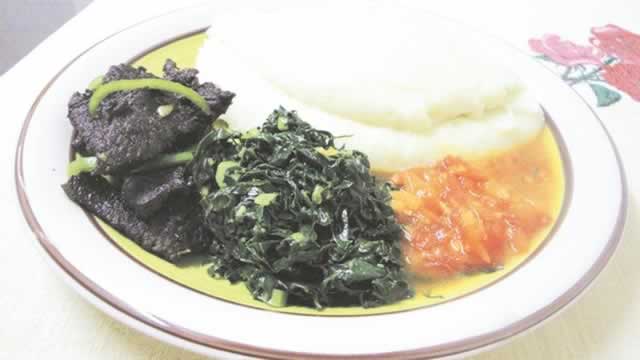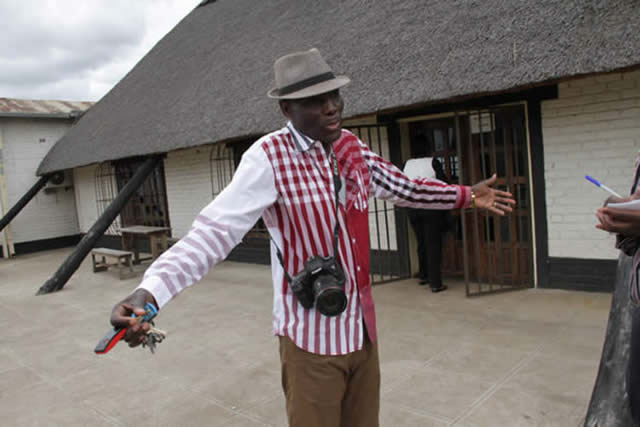Longing for sadza in the year of El Nino


In bountiful years, it was normal for rural folk to eat sadza for breakfast or munya, sadza for lunch and sadza for dinner
Sekai Nzenza on Wednesday
That warm weather called El Nino has come to Zimbabwe and to the rest of Southern Africa, causing the current drought. This is why you see the maize falling before it ripens. The stalks are becoming fodder, cattle food or mashanga.
“THIS year, you Africans addicted to sadza will have to learn to eat potatoes, rice and spaghetti!” said my cousin Reuben, the one who lives in Australia.
After many years in the Diaspora, Reuben talks as if he is not from here, like he is a tourist visiting us.
This attitude happens to some of us who have been away from this country for a long time.
We come back talking like we do not belong here.
Sometimes we are not even conscious of it. Reuben is like that. But we often remind him to come back to the soil and remember where he came from.
He grew up right here in the village where he used to herd cattle down in the valley and walk several kilometers to school barefoot.
Like all of us, Reuben ate sadza for breakfast or munya, sadza for lunch and sadza for dinner.
But, in those days, when we were growing up in this village, we ate varieties of sadza.
Not just white sadza, but many types and colours of sadza.
My grandmother, Mbuya VaMandirowesa, cooked sadza from millet, sorghum, rice and other grains such as mapfunde. Our sadza was eaten with varieties of vegetables.
Mbuya VaMandirowesa also spent a long time preparing the red millet or rapoko sadza.
Then she cooked a village road runner chicken to accompany the millet sadza, rezviyo.
At times, we milked cows and made the village sour milk.
Meat was in abundance from cattle, goats, sheep, ducks and chickens.
Fishermen dodged crocodiles and hippos and caught big fish in the Save River. My grandfather, Sekuru Dickson, used to take his gun and go hunting in the Mbire Mountains. He brought home big game meat. Sekuru did not kill elands, because that is our totem.
Our childhood years were full of plenty even though the Rhodesian government had forced us to live in the tribal trust lands or TTLs. Most of the good land with lots of rainfall had been given to British settlers soon after the First World War. We worked hard in the fields, ate sadza and survived.
Food handouts were unknown. Donors or the word donor did not exist. The chief looked after widows and many other poor vulnerable people through what they called Zunde Ramambo. Although there were stories of poor people who used to move from one village to another asking for food, hunger was rare.
I recall that there was a man called Munhenga whose fame for growing rapoko or millet stretched from here to Mbire, way across the Save River. Sometimes Munhenga hired labourers to cut the millet and harvest the maize.
Munhenga’s jakwara, or the rapoko threshing and harvesting ceremony, was the marker of village time.
He grew varieties of millet and not once did he not have a jakwara in August. The women brewed beer for the jakwara at Munhenga’s homestead. On the seventh day, relatives and neighbours began drinking warm beer in preparation for the main ceremony the following day. At sunrise, the millet was laid out in a huge pyramid on the flat rocks, paziru- ware.
Men brought long threshing sticks cut from branches of the mutondo trees. They drank a lot of beer claiming it brought more energy to beat the millet. The women swept the grain around the ruware, ready for the winnowing at the completion of threshing. Munhenga’s millet and sorghum filled many granaries.
Munhenga had many cattle, goats and sheep. We used to help Munhenga’s sons to round up all the livestock towards sunset. We counted them all in the school grounds, in case one strayed away. Munhenga was so rich that his two wives and many children ate meat every single day. His family had more food than they could eat. He gave away many bags of grain to widows and those who were unable to harvest from their poor soils.
During Munhenga’s time, rains came when they were expected.
This year, for the second year running, our maize crop is a disaster. We would be lucky to harvest anything at all from our five hectares of sandy soils.
In November last year, when the rains came, we said God and the ancestors had not forgotten to send us rain at the right time. Then we got the ploughs out and planted commercial type maize seeds. We no longer use the seeds from last year’s season from the granaries, because those seeds will not germinate well. A few days later, the maize germinated and the whole field was a beautiful sea of green. People stopped to admire our field, asking what seed we used and what fertiliser we were going to apply.
Then the rains stopped coming.
In December last year, for the second year in a row, our first crop died. We replanted again and waited. The germination of maize was very good again. We added fertiliser at the right time. When the maize was just above knee in height, the rain disappeared again. Every day, people looked to the sky. But no rain came.
For the past month, people have been praying in churches, hoping that the El Nino effect repeatedly mentioned on the radio would go away.
“El Nino, El Nino. What El Nino? We have forgotten to worship God and to acknowledge our ancestors. We are being punished by higher powers,” said my cousin Piri in exasperation.
Reuben then explained that El Niño means the “Little Boy”, or “Christ Child” in Spanish. It is a complicated weather pattern caused by changes in ocean temperatures. A long time ago this El Niño was discovered by fishermen on the coast of South America in the 1600s when they felt that there was very hot weather on the coast of the Pacific Ocean around December.
That warm weather called El Nino has come to Zimbabwe and to the rest of Southern Africa, causing the current drought. This is why you see the maize falling before it ripens. The stalks are becoming fodder, cattle food or mashanga.
My brother Sydney, being the teacher that he is, held a dry maize stalk that dried up before tasselling. He agreed with Reuben. “El Nino is a fact, especially to those who read and understand geography and the environment. El Nino can return after seven or more years.”
“In the year of El Nino, people must learn to eat other foods, apart from sadza, in order to survive,” said Reuben.
Reuben then said maize came from Mexico and was introduced to us by Portuguese traders more than 150 years ago. The British settlers offered it to us because it was easier and quicker to cook sadza than to prepare rapoko flour. To save food preparation time, road workers, miners and farm workers were encouraged to make a quick sadza meal to be eaten with vegetables, dried fish or small pieces of salted meat.
Over the years, we have adopted maize as our staple food. Now we eat it every day, because we are so accustomed to growing and eating it. Without maize meal in the house, the face of hunger is everywhere.
“This year, pregnant women will give birth and call their children El Nino,” Reuben said, laughing and filming the fallen maize in the fields, caused by the severe drought.
“It’s not funny,” said Piri. “Why do you always find humour in serious painful situations?” Reuben laughed even more. He turned his video camera towards Piri and started filming again.
“The point of my story is this one: We Africans have learnt to ease our pain through humour. We share the pain. Remember what Bokina said last week? He said, if the rains were not falling in his field alone, he would have hanged himself. But, has he done that? No. Why not? Because Bokina is not the only one without maize around here.”
Piri did not see any humour or joy in Reuben’s filming. “Itori hapana hapana gore rino. Chibage chakaroverwa pasi nezuva. Zvegore rino inzara takarima,” said Piri, meaning this year, all the maize has been hit hard by the sun. It is the year of hunger, despite all the hard work that has gone into growing maize.
Shall we continue to long for sadza, in the year of El Nino? Perhaps it is time we learnt to eat something else.
Dr Sekai Nzenza is a writer and cultural critic.










Comments